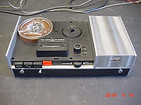
Sony TC-50
This is the Sony TC-50 cassette recorder. This unit came out in 1968, and was the smallest cassette machine produced at the time.
This model is famous as it was the model chosen by NASA to be taken aboard the command module of the Apollo moon missions.
There is a strong possibility this unit has actually been used by NASA, but not apparent in the pictures. The units used by the Apollo program (there was more than one) had a metal sticker on the front with operating instructions, as well as a special serial number stamped. The jacks were taped to make then unuseable. Velcro was affixed to the rear of the unit to facilitate the machine being stuck to the wall in the microgravity environment.
I have acquired two TC-50's. One was found at an estate sale back in 2007 or so. It was in very good cosmetic condition, but the motor had a problem that I made worse when trying to fix (it was my first attempt at a TC-50 repair). Later in 2013, I went to a now out-of-business place called "The Black Hole" in Los Alamos, New Mexico.
Ricky's Web Pages
"Once you label me, you negate me." --Søren Kierkegaard
This is a classic early-1980s or so vintage desktop style "shoebox" cassette recorder, which would fit right in in an office for recording notes and so-forth. It is a very good quality recorder.

A very nice Japanese recorder of the 1960s. This one has a nice stand-up style with the 2.5" reels at the top. The unit runs at either 3 3/4 IPS or 1 7/8 IPS, although it does not change the equalization. Sound quality is very good with this AC bias, DC erase recorder. Can run on a battery of cells or 120VAC.

Norwood 1012 XLP
This is a very interesting model of tape recorder. At first glance, it looks rather typical for a 1970s-era recorder. But this has a special feature--two speeds--standard speed and QUARTER speed. On top of that, it is a 4-track mono recorder, recording discretely on all four tracks normally found on two-sided stereo cassettes. This therefore can use four times the tape's length for LONG record time.

"That's one small step for a man, one giant leap for mankind"
This unit came out in 1968 and has had greatly use in space-age history.
Click to read more.

A really cool-styled 1960s-era Japanese classic. This unit boasts a tape counter, mechanical (momentary) pause, and easily switchable between 4.75 cm/sec and 9.5 cm/sec, complete with equalization change. Sound quality is very good, and even at the slower speed sounds decent. AC bias, permanent magnet erase.

Grundig TK-1
A very nice little 3-inch recorder made in Germany in about 1960. Although transistorized, it does use a DM71 seeing-eye tube. This AC bias, AC erase unit only runs at 3 3/4 IPS and has delicious sound quality. Battery-operated from four 'D' cells and two AA cells.


Uher 4000 Report-S
This recorder was manufactured in 1964 in Western Germany. It is a very high quality unit boasting four speeds of 15/16 IPS, 1 7/8 IPS, 3 3/4 IPS, and 7 1/2 IPS. It has all-metal construction and sounds fan-freakin-tastic. AC bias, AC erase.
This model was common for use in broadcasting and film. My late Uncle Ricky used to use a Uher 4000 for film use.



This is a classic early-1980s or so vintage desktop style "shoebox" cassette recorder, which would fit right in in an office for recording notes and so-forth. It is a very good quality recorder.

This is a very nice rechargeable portable recorder. This rare American-made unit is from 1965. It is not meant to have the batteries replaced as one normally would, but came with a rechargeable battery pack. I have since installed eight NiMH cells inside, and (due to their crappy performance) plan on upgrading to Li-Ion, with added support circuitry.
